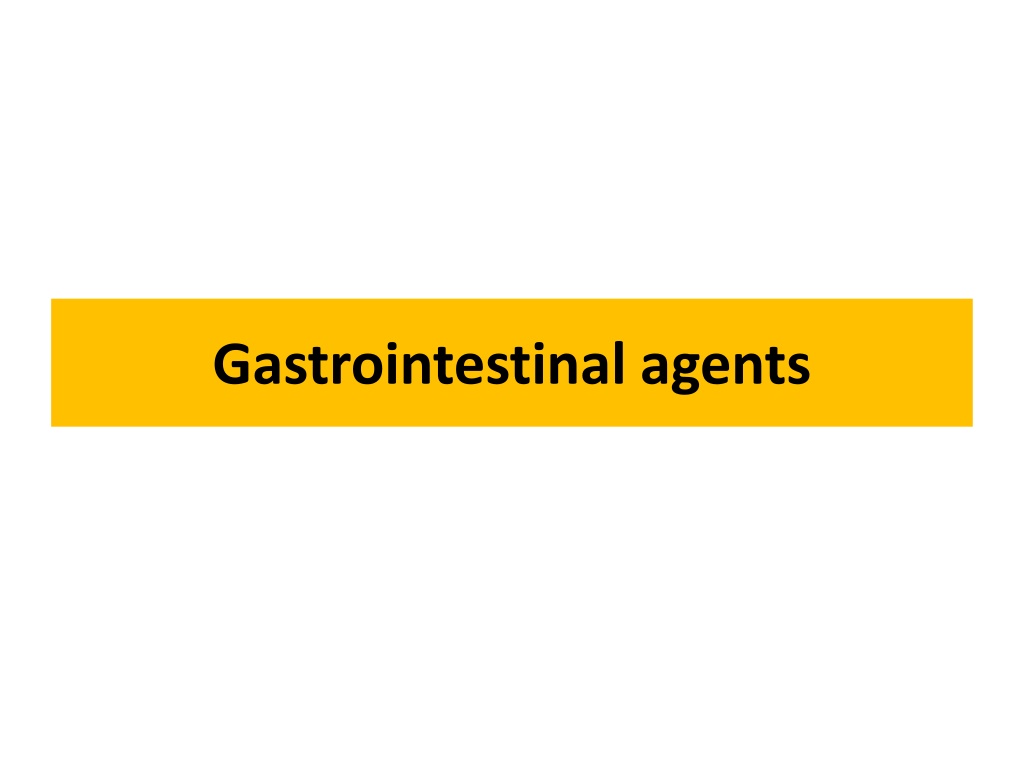Understanding Gastrointestinal Agents and Disorders
Learn about gastrointestinal agents used in the treatment of GIT disorders such as achlorhydria, hyperacidity, diarrhea, and constipation. Explore the classification of gastrointestinal agents including gastric acidifiers, antacids, protectives, adsorbents, and cathartics. Discover the causes and symptoms of achlorhydria, a condition characterized by the absence of stomach acid secretion, and the treatment options involving dilute hydrochloric acid. Dive into the properties and uses of hydrochloric acid in managing gastrointestinal issues.
Download Presentation

Please find below an Image/Link to download the presentation.
The content on the website is provided AS IS for your information and personal use only. It may not be sold, licensed, or shared on other websites without obtaining consent from the author. Download presentation by click this link. If you encounter any issues during the download, it is possible that the publisher has removed the file from their server.
E N D
Presentation Transcript
Define and classify gastrointestinal agents with examples. GIT agents- These agents are used in the treatment of GIT disorders such as achlorhydria, hyperacidity, diarrhoea & constipation. or The agents which are used in the treatment of gastrointestinal disorder are called as gastrointestinal agents.
Classification: 1. Gastric acidifier- Dilute Hydrochloric acid 2. Antacids A) Systemic/ Absorbable antacids E.g. Sodium Bicarbonate B) Non systemic/ Non absorbable antacids
a)Aluminium containing antacids. b) Calcium containing antacids. c)Magnesium containing antacids. d)Combination antacids - Aluminium Hydroxide and Magnesium hydroxide, Aluminium Hydroxide gel and Magnesium trisilicate
3. Protectives & adsorbents) Bismuth containing compounds: Bismuth subcarbonate, Bismuth subnitrate, Milk of bismuth. b)Activated clays: Light kaolin, Activated charcoal. 4. Cathartics Laxatives: Methyl cellulose, Sodium carboxy methyl cellulose, Liquid paraffin. b) Purgatives: Magnesium hydroxide, Sodium Potassium tartrate etc.
Achlorhydria Achlorhydria defined as the condition in which there is no secretion of HCl in stomach. Symptoms Frequent bowel movement Mild diarrhoea Epigastric pain and abdominal pain Sensivity to spicy food
Reasons of achlorhydria Gastric mucosal atropy Stomach carcinoma Gastric polys Chronic nephritis Chronic alcoholism Tuberculosis Hyperthyroidism
Drug used in treatment of achlorhydria? Dilute hydrochloric acid is used for treatment of achlorhydria. It increase gastric HCl level.
Hydrochloric acid Molecular formula- HCl Molecular wt: 36.46 Synonyms: Muriatic acid Properties: It is colorless fuming liquid It has pungent odour It is soluble in water It react with silver nitrate to form white precipitate of silver chloride. It react with alkali to form salt and water.
Uses: Acidifying agent Used for extraction of alkaloids Gastric acidifier Storage condition It should be stored below 30ocin glass stoppered container Chemical incompatibilities: With alkalies, salt ofAg, Hg, and lead
Antacids Antacids are the drugs or preparations which neutralize the excess hydrochloric acid secreted in the G.I.T. These drugs give relief of pain caused due to hyperchlorhydria. Or Antacid are the drugs which are usually weak bases used for neutralizing excess acid in the stomach of the patient suffering (Hyperacidity). from hyperchlorhydria
Ideal characteristics of an antacid- It should not be absorbable and cause systemic alkalosis. It should not be laxative or cause constipation. It should exert effect rapidly & over a long period of time. It should buffer in pH 4-6. It should not produce large volume of gas. It should be palatable & inexpensive. It should probably inhibit pepsin.
Classification- I) SystemicAntacids- These are also called as absorbable antacids. They are water soluble and get readily absorbed and produce systemic electrolyte alterations and finally systemic alkalosis. It causes retention of Na and electrolyte disturbances. Due to this acid base balance of the body gets disturbed. e.g.- Sodium bicarbonate.
II) Non Systemic Antacids- These are also called as Non absorbable antacids. These compounds are generally water insoluble & so do not get absorbed to a significant concentration in the system. These are further classified as follows- Aluminium containing antacids E.g-Aluminium hydroxide, aluminium phosphate.
Calcium containing antacid E. g- Calcium carbonate, Calcium hydroxide, Tribasic Calcium phosphate. Magnesium containing antacide. g- Magnesium carbonate, Magnesium trisilicate, Magnesium oxide.
Combination antacid preparation- Combination ofAl(OH)3gel and Mg(OH)2 Combination ofAl(OH)3gel and Magnesium trisilicate Combination ofAl(OH)3gel gel and CaCO3 Combination ofAl(OH)3gel, CaCO3and Mg(OH)2
Rational behind the combination of antacid preparations 1. No single antacid meets all requirements for ideal antacid hence many marketed antacid preparations contain more than one drug. 2.Antacids are used in combination because, i) To balance constipating effect of Aluminium & Calcium antacids with laxative effect of Magnesium antacid. e.g.Aluminium Hydroxide and Magnesium hydroxide, Aluminium Hydroxide gel and Magnesium trisilicate
ii) Some antacids produces rapid onset of action (e.g. Calcium carbonate) and some antacids induces slow action but for longer period (e.g.Aluminium hydroxide). Hence to get rapid & longer duration of action antacids are used in combination. 3. Few antacids contain antiflatulents. e.g. Simethicone, dimethicone and reflux suppressants like alginic acid.
Examples: 1.Al(OH)3gel and Mg(OH)2 2.Al(OH)3gel and Magnesium trisilicate 3.Al(OH)3gel, CaCO3and Mg(OH)2 4. Sodium bicarbonate & alginic acid 5. Simethicone containing antacids 6.Aluminium hydroxide gel & kaolin combination
Sodium bicarbonate Molecular formula-NaHCO3 Molecular wt: 84 Synonym : Baking soda Physical properties It is white odourless crystalline powder It is saline in taste Soluble in water but insoluble in alcohol Its aqueous solution is alkaline in nature
When it is treated with acid it form salt and water. It is stable in air but in moist air it decomposes as N a H CO 3 + H Cl N a Cl + H 2 O + CO 2 Na 2 C O 3 + H 2 O + C O 2 2 N a H C O 3 Storage Store in well closed containers Incompatibilities With tetracycline, acids salts.
Preparation NaHCO3 may be obtained by the reaction of carbon dioxide with an aqueous solution of sodium hydroxide. The initial reaction produces sodium carbonate. Further addition of carbon dioxide produces sodium bicarbonate CO2 + 2 NaOH Na2CO3 + H2O Na2CO3 + CO2 + H2O 2 NaHCO3
Uses of sodium bicarbonate It is used asAntacid. It is used as systemic antacid in treatment of systemic acidosis. It is used as electrolyte replenisher. 3 to 5% solution in warm water is used as eye lotion. It is used as an ingredient of compound NaHCO3 tablets. It is also used in effervescent antacid.
Assay Weigh accurately 1gm of Sodium bicarbonate and dissolve in 20 ml of water, titrate the solution with 0.5N sulphuric acid using methyl orange as indicator. - Each ml of 0.5N sulphuric acid 0.0425gm of NaHCO3
Aluminium hydroxide Molecular formula-Al(OH)3 Molecular wt: 77.99 Properties It is white viscous suspension Small amount of clear liquid may be separated on standing It is translucent in nature It has pH between 3 to 5 It is sweet in nature due to sweeting agent It does not affect phenolphthalein indicator. It is insoluble in water and alcohol but soluble in mineral acids.
Uses of aluminium hydroxide gel It is non systemic or non absorbable antacid. Externally it is used as mild astringent. Used in the treatment of diarrhea & cholera. Externally used as dusting powder. Storage The gel should be stored at temperature not exceeding 25ocand it should not allowed to freeze.
Magnesium hydroxide mixture Molecular formula: Mg(OH)2 Molar mass: 58.31 g/mol Mg2+ Salts or Oxide or Hydroxide acts as both antacids and laxative agents. Properties Appearance : White amorphous powder Odor : Odorless Taste : Tasteless Melting point : 3500 C Solubility : Insoluble in water Refractive index : 1.55
Preparation: Combining a solution of many magnesium salts with basic water induces precipitation of solid Mg(OH)2: Mg2+ + 2 OH Mg(OH)2 Uses Used as weak antacid and laxative. Most commonly used antacids combine aluminum hydroxide and magnesium hydroxide. The combination decreases the adverse effects of diarrhea (with magnesium products) and constipation (with aluminum products). Calcium carbonate is effective in relieving heartburn, but it is infrequently used to treat peptic ulcers or GERD
Cathartics These are the drugs which gives relief from constipation. Or these are the drugs which brings defecation.
Mechanism action of cathartics 1.Bulk producing drugs: These drugs promote evacuation by increasing the stool bulk volume and water content. e.g. Isapgol, agar-agar, methylcellulose 2. Stool softners/ Emollient: It penetrates, lubricates and softens the stools. e.g. Liquid paraffin, mineral oils etc.
3. Stimulant/ Strong purgatives/ Irritant purgatives: It causes local irritation on the intestinal tract, which increases peristaltic activity. e.g. Phenolphthalein, senna glycosides, aloe, rhubarb extract, castor oil etc.
4. Osmotic laxatives/ Saline cathartics: These are salts of poorly absorbable ions which increases osmotic load on intestinal tract which is relieved by secretion of addition fluids in the intestinal tract. Hence these agents increase fluidity of intestinal tract by retention of water by osmotic forces. e.g. Antimony potassium tartrate, sodium phosphate, magnesium sulphate, sodium sulphate, potassium phosphate etc.
Laxatives Laxatives are substances that loosen stools and increase bowel movements. They are used to treat and prevent constipation. Classification: 1. Laxatives A) Bulk producing drugs- Isapgol, agar-agar, methyl cellulose, sodium carboxy methyl cellulose B) Stool softners (Emollient) - liquid Paraffin
2. Strong purgatives A) Irritant/Stimulant purgatives- senna glycoside, phenolphthalein, aloe, castor oil, rhubarb. B) Saline cathartics/ Osmotic laxatives (i) Sodium containing products- Sodium potassium tartrate, Sodium phosphate. (ii) Magnesium containing products- Magnesium hydroxide, Magnesium sulphate, Magnesium Citrate.
(iii) Sulfur as cathartic (iv) Non official Cathartics- Sodium sulphate, Potassium phosphate.
Magnesium sulphate Molecular formula: MgSO4.7H2O Molecular weight : 246.47 Synonym: Epsom salt Properties : It occurs as colourless crystals, with cool, saline and bitter taste. It effloresces in dry air. It is freely soluble in water, sparingly soluble in alcohol and dissolves slowly in glycerin.
Uses Magnesium sulphate is used as a saline cathartic. It is not absorbed in intestinal tract, so it increases the hydrostatic pressure on intestine and increases the peristaltic activity. It is also used as an antidote in Heavy metal poisoning.
Wet dressings of a 25% solution of magnesium sulphate are sometimes used in the treatment of carbuncles & boils. It should be used with care as a laxative in patients with impaired renal functions Storage Store in air tight container in cool place.
Kaolin Molecular formulaAl2O3. 2SiO2. 2H2O Molecular weight : 258. Synonym: China clay Properties: It occurs as a soft white or yellowish white powder. odourless and has clay like taste.
When moistened with water, assumes a darker color & develops a marked clay-like odor. It is insoluble in water, in mineral acids and in solution of alkali hydroxides. Chemically, it is practically inert, since it is insoluble in all the common solvents.
Uses:- It is used in mixtures intended for treatment in dysentery, diarrhoea and for symptomatic treatment of colitis, cholera etc. It is employed in the treatment of food and alkaloidal poisoning as it adsorbs toxins. It also finds use in dusting powder, cosmetic preparations and is an ingredient of Kaolin poultice.
References Pharmaceutical inorganic chemistry volume I, by G. R. Chatwal published by himalaya page no. 152. https://www.google.co.in/image























